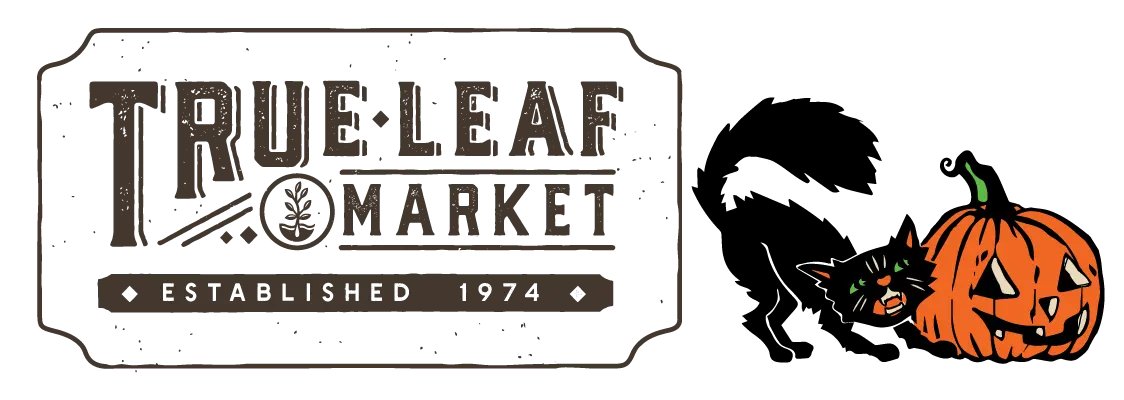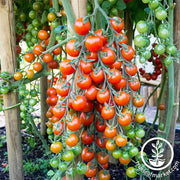DESCRIPTION
Supersweet 100 Hybrid Tomato - Hybrid Garden Seeds
Download Free Vegetable Growing Guide PDF
The Supersweet 100 Hybrid Tomato plant (Lycopersicon esculentum), is a favorite among foodies. It is packed with flavor and contains more vitamin C than other cherry tomato varieties. Indeterminate, growing in long clusters of about quarter-sized tomatoes.
The Supersweet 100 Hybrid Tomato is best grown in hardiness zones 6-14. The soil must be between 75-90° F in order for the plant to germinate. If sowing outdoors, wait till nighttime temperatures are at or above 60° F until you start. You may be able to get a second harvest the following year.
Supersweet 100 has a long growing season, allowing you to harvest many times over the summer. And as long as the weather is warm and it continues to get sun, this tomato plant will keep producing! Harvest when tomatoes show deep color and are firm to the touch.
Sowing: Sow tomatoes indoors 6-8 weeks before the last frost date. Keep soil at 75° F. Seedlings should emerge in 7-14 days. Or sow outdoors well after the last frost date when nighttime temperatures have stayed 60° F and above for two weeks, which is also the indicator to begin the transplanting process as well.
Transplanting: If sown indoors, harden off your plants for a period of two weeks before transplanting. Without hardening off, your plants may die from "transplant shock." Make sure you plant in an area that hasn't grown peppers, eggplant, potatoes, or other tomatoes for the last two years. Plant deeply, covering the roots and stem up to the first set of leaves.
Soil Preference: Keep soil warm and moist! Water a lot just after transplanting and maintain a moist but not soggy consistency. Make sure your soil has good drainage and won't be likely to accumulate standing water at the base of the plant.
Other Tips: Mulches can help keeps weeds down and maintain even soil temperatures, which contribute to a healthy plentiful garden plant. Supersweet 100 Hybrid Tomatoes require a trellis system of some kind. Simple cages and box trellises work just great!
=======
ATTRIBUTES
Basic Info
| Latin Name: |
Solanum lycoperscium (Previously Lycopersicon esculentum, however this name is no longer accepted as correct)
|
| Tomato Type: |
Cherry - Small round tomatoes that are typically the size of marbles but still smaller than a golf ball. |
| Supersweet 100 Hybrid Tomato Color: |
Red |
| Supersweet 100 Hybrid Tomato Flavor: |
Sweet |
Growing Info
| Hardiness Zone: |
2, 3, 4, 5, 6, 7, 8, 9, 10, 11 Annual: Not intended to overwinter |
| Days to Maturity: |
70 |
| Days to Germination: |
7-10 |
| Seeding Depth: |
0.25 inch |
| Plant Spacing: |
24 to 36 Inches |
| Row Spacing: |
36 inches |
| Plant Height: |
36 to 96 Inches |
| Growth Habit: |
Indeterminate - Indeterminate tomatoes are vine-type plants that sprawl (requiring a cage or trellis to support them) and continue to grow throughout the season. Indeterminate tomato plants will continue to produce tomatoes for the rest of the season, so you can harvest continually. |
| Soil Preference: |
Well-draining, loose (sandy loam), slightly acidic (6.2 to 6.8), and moisture retaining. Too much nitrogen in the soil may lead to more foliage production and less fruiting. Tomatoes like more phosphorus and potassium than other vegetables. |
| Temperature Preference: |
Warmer (70-85 F) |
| Light Preference: |
Full Sun |
Other
| Direct Sow: |
No |
| Start Indoors: |
Yes. Start Indoors 7-9 weeks before your last spring frost date. |
| Plant Width: |
24 to 36 Inches |
| Growth Speed: |
Mid - Ready to harvest 70 to 80 days from transplant. Tricky to get a tomato by the 4th of July with these varieties. They are good mid-summer producers for most USDA Zones. |
| Germination Temperature: |
65-85 F |
| Pests and Diseases: |
Resistant to Early Blight, Fusarium Wilt, Fusarium Wilt 1, Late Blight, Tobacco Mosaic Virus, Verticillium Wilt, Verticillium Wilt 1, Verticillium Wilt 2. Common pests known to harm tomato plants, in general, include the tomato hornworm, cutworm, aphids, flea beetles, tomato fruit worms, and whiteflies. Also, watch for common diseases such as blossom end rot, fusarium wilt, powdery mildew, verticillium wilt, late blight, bacterial canker/spot, and tobacco mosaic virus. Most of these can be prevented by maintaining a regular watering schedule and avoiding overwatering. Regularly check your plants for pest damage throughout the season. For treating pest and disease problems, we recommend using an organic neem-based product. |
| Garden Size: |
Greenhouse, Garden Plot, Raised Bed, Container, Large Hanging Basket |
| Tomato Use: |
Salads, fresh eating |


















